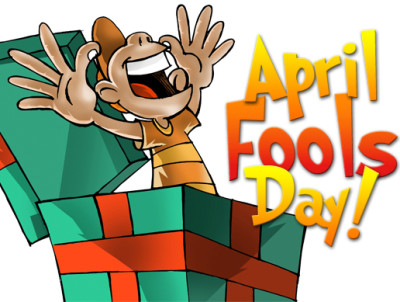
The 60s Official Site
"Where Music is Our Middle Name"
Quick Links
Your Daily Oldies Fix Top Ten Countdown Solid Gold Memories Jukebox Music
Vibration of a Nation Remember When Television of the 50s and 60s 60s Slang
Things You Just Don't Hear Anymore 60s TV Commercials Chickenman Episodes Woodstock This Weeks Number One Hits
The Early Years of Rock and Roll Vietnam War Myths
All the content menu is listed on the left menu border bar
Let us be thankful for the
fools. But for them the rest of us could not succeed." -- Mark Twain April Fools' Day is observed throughout the Western world. Practices include sending someone on a "fool's errand," looking for things that don't exist; playing pranks; and trying to get people to believe ridiculous things. We as children during the 50s and 60s had our own gags and tricks from the obvious "your shoe is untied," or to when somebody bent over you tore a sheet of paper to sound like that person's pants had ripped. Even the cherry bomb in the toilet routine was a 50s and 60s gag. Today many gags and jokes are sent via email. So be on the watch. The origin of April Fools Day is unclear but many historians seem to think it came when calendar changes were made during the Midieval Times. (Julian Calendar to the Gregorian Calendar) The first month of the year was changed from March to January. It came to pass that anybody that was still going by the Julian Calendar was an April Fool. I am not going to bore you with specifics on this but only to say that the fools day acronym probably established itself due to change of winter to spring thus resulting in gleefulness and foolishness the season presented. I know after a long cold winter we all become giddy when the warm weather arrives. (at least I do) Over the years many gags and jokes were presented by newspapers, TV and of course radio. I have highlighted four of the funniest, some of which you may remember. Tower of Pisa: The Dutch television news reported once in the 1950s that the Tower of Pisa had fallen over. Many shocked people contacted the station. In 1957 the respected BBC news show Panorama announced that thanks to a very mild winter and the virtual elimination of the dreaded spaghetti weevil, Swiss farmers were enjoying a bumper spaghetti crop. It accompanied this announcement with footage of Swiss peasants pulling strands of spaghetti down from trees. Huge numbers of viewers were taken in. Many called the BBC wanting to know how they could grow their own spaghetti tree. To this the BBC diplomatically replied, "place a sprig of spaghetti in a tin of tomato sauce and hope for the best." In 1933 Madison Capital-Times solemnly announced that the Wisconsin state capitol building lay in ruins following a series of mysterious explosions. The explosions were attributed to "large quantities of gas, generated through many weeks of verbose debate in the Senate and Assembly chambers." Accompanying the article was a picture showing the capitol building collapsing. Many readers were fooled—and outraged. One reader wrote in declaring the hoax "was not only tactless and void of humor, but also a hideous jest." Nevertheless, in 1985 The Science Digest named this as one of the best hoaxes ever. Special Note: Our Capital Building in Washington sure has a lot smelly stuff coming out of it lately. Smell-o-vision - In 1965 BBC TV featured an interview with a professor who had just invented a device called "smellovision." This miraculous technology allowed viewers to experience directly in their own home aromas produced in the television studio. The professor offered a demonstration by cutting some onions and brewing coffee. A number of viewers called in to confirm that they distinctly experienced these scents as if they were there in the studio with him. Since no aromas were being transmitted, whatever these viewers thought they smelled coming out of their tv sets must be chalked up to the power of suggestion or being a typical April Fool. You be the judge. "Looking foolish does the spirit good." -- John Updike
|
|





